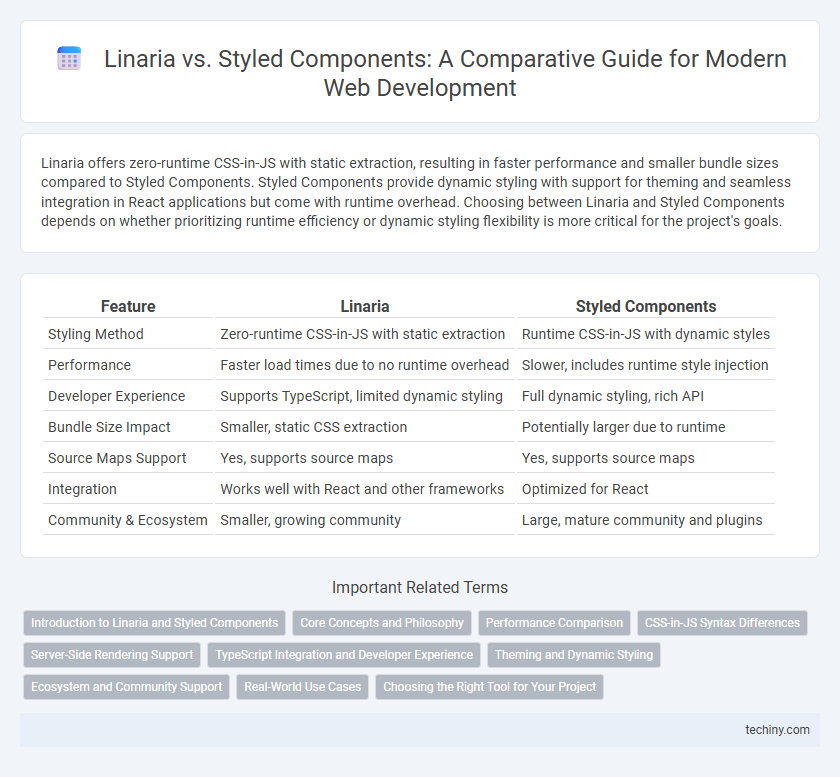Linaria offers zero-runtime CSS-in-JS with static extraction, resulting in faster performance and smaller bundle sizes compared to Styled Components. Styled Components provide dynamic styling with support for theming and seamless integration in React applications but come with runtime overhead. Choosing between Linaria and Styled Components depends on whether prioritizing runtime efficiency or dynamic styling flexibility is more critical for the project's goals.
Table of Comparison
| Feature | Linaria | Styled Components |
|---|---|---|
| Styling Method | Zero-runtime CSS-in-JS with static extraction | Runtime CSS-in-JS with dynamic styles |
| Performance | Faster load times due to no runtime overhead | Slower, includes runtime style injection |
| Developer Experience | Supports TypeScript, limited dynamic styling | Full dynamic styling, rich API |
| Bundle Size Impact | Smaller, static CSS extraction | Potentially larger due to runtime |
| Source Maps Support | Yes, supports source maps | Yes, supports source maps |
| Integration | Works well with React and other frameworks | Optimized for React |
| Community & Ecosystem | Smaller, growing community | Large, mature community and plugins |
Introduction to Linaria and Styled Components
Linaria is a zero-runtime CSS-in-JS library that enables writing CSS styles with real syntax directly in JavaScript, improving performance by extracting styles at build time. Styled Components offers a dynamic approach to styling React components by utilizing tagged template literals, generating unique class names at runtime for scoped styles. Both libraries enhance component styling but differ in execution timing and performance optimization strategies.
Core Concepts and Philosophy
Linaria focuses on zero-runtime CSS-in-JS by extracting styles at build time, improving performance by generating static CSS files. Styled Components embraces dynamic styling with runtime style generation, offering powerful theming and component-scoped styles. The core philosophy of Linaria emphasizes static CSS efficiency, while Styled Components prioritizes flexibility and developer experience through dynamic styles.
Performance Comparison
Linaria offers superior runtime performance by compiling CSS at build time, eliminating the overhead of JavaScript-in-CSS processing during execution, which results in faster page loads and reduced bundle sizes. Styled Components injects styles through JavaScript at runtime, increasing CPU usage and rendering time, especially in large-scale applications with dynamic styling. Benchmark tests show Linaria can reduce style processing time by up to 50% compared to Styled Components, making it ideal for performance-critical web projects.
CSS-in-JS Syntax Differences
Linaria uses static CSS extraction which relies on standard CSS syntax inside tagged template literals, resulting in zero-runtime CSS and better performance. Styled Components utilizes dynamic CSS-in-JS with template literals, embedding styles directly in JavaScript, enabling powerful theming and dynamic styling but adding runtime overhead. Linaria's approach emphasizes static extraction while Styled Components focuses on runtime styling flexibility.
Server-Side Rendering Support
Linaria offers zero-runtime CSS-in-JS with full server-side rendering (SSR) support by extracting styles at build time, resulting in faster page loads and improved performance. Styled Components also supports SSR by generating CSS on the server and injecting it into the initial HTML, but this runtime approach can increase CPU usage and initial render time. Choosing Linaria can lead to more efficient SSR through static style extraction, while Styled Components provides dynamic styling at the cost of extra runtime processing during server rendering.
TypeScript Integration and Developer Experience
Linaria offers zero-runtime CSS-in-JS with first-class TypeScript support, enabling type-safe styled components without impacting bundle size or load time. Styled Components provides robust TypeScript integration with extensive type definitions but introduces runtime overhead that can affect performance. Developers favor Linaria for its faster build times and seamless static extraction, while Styled Components is preferred for rich theming capabilities and mature ecosystem in complex React projects.
Theming and Dynamic Styling
Linaria offers zero-runtime CSS-in-JS with static extraction, improving performance by generating CSS at build time, which benefits theming through predictable and efficient style recalculations. Styled Components enables dynamic styling with powerful theming support via ThemeProvider, allowing styles to adapt based on props and theme context at runtime. For projects prioritizing runtime flexibility and dynamic theme changes, Styled Components excels, while Linaria suits applications that require fast initial load times and static CSS for theming consistency.
Ecosystem and Community Support
Linaria and Styled Components both have active ecosystems, but Styled Components boasts a larger community with extensive third-party integrations, plugins, and resources. Linaria offers zero-runtime styling, attracting developers focused on performance and static analysis, though it has comparatively fewer community contributions. The Styled Components ecosystem includes comprehensive documentation and widespread adoption in major projects, facilitating easier troubleshooting and collaborative development.
Real-World Use Cases
Linaria excels in real-world web development projects requiring zero-runtime CSS-in-JS with static extraction, making it ideal for performance-critical applications. Styled Components offers dynamic styling capabilities and theming, preferred in complex React applications needing runtime style adjustments or prop-based styles. Large-scale projects often combine Linaria for global styles and Styled Components for interactive UI elements, balancing static optimization with runtime flexibility.
Choosing the Right Tool for Your Project
Linaria offers zero-runtime CSS-in-JS by extracting styles at build time, enhancing performance and reducing bundle size, ideal for projects prioritizing speed and SSR support. Styled Components provides dynamic styling with rich theming and automatic critical CSS, best suited for applications requiring highly interactive and styled React components. Evaluate project needs such as performance constraints, developer experience, and styling complexity to select the optimal tool between static extraction and runtime styling.
Linaria vs Styled Components Infographic

 techiny.com
techiny.com